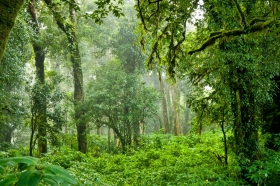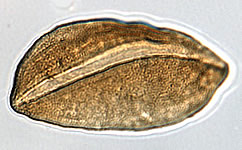Antarctica's tropical past is revealed

Antarctica was once home to a diverse range of tropical plants including ferns, palms and rainforest trees, say scientists.
They have uncovered the first direct evidence of a much warmer, greener continent in the Southern Ocean. They publish their findings today in Nature.
The researchers took a research ship to Wilkes Land off Antarctica's eastern coast, where they drilled a kilometre deep into the ocean floor. The layers of sediment they extracted contain tiny fossils and chemicals, trapped in a snapshot of time.
Dr James Bendle from the University of Glasgow was one of the team who took part in the study. He says, 'In the sediments we found fossilised pollen representing two distinct environments with different climatic conditions - a lowland, warm rainforest dominated by tree-ferns, palm trees and baobab trees; and a cooler mountainous region dominated by beech trees and conifers.'
Baobab trees are native to Madagascar and are also known as the 'tree of life', because their swollen trunks can store water.
'Several of the rainforest pollen types come from trees which are insect-pollinated — including the palms and baobab — but also Macadamia, which produce the delicious nuts we enjoy today,' adds Bendle. 'Pollen from both environments would have been washed, blown or transported by insects into the shallow coastal shelf, where it settled in the mud and was preserved for the past 50 million years or so.'
The pollen shows that temperatures around the Antarctic coast would have been around 16°C, with summers reaching a balmy 21°C and winters staying over 10°C even during the three months of darkness. Further evidence of these mild temperatures came from preserved organic molecules, produced by soil bacteria that would have lived in soils along the coast.

52 million-year-old palm pollen grain from Antarctica.
Bendle warns that their work carries a sobering message, though. In the 'Greenhouse World' of the Eocene period, which lasted between 48 and 55 million years ago, carbon dioxide (CO2) levels in the atmosphere would have been more than twice as high as they are today.
'But CO2 levels are rising rapidly through our burning of fossil fuels and deforestation,' says Bendle. 'We haven't reached Eocene levels yet, but we are increasing faster than any time in Earth's history.'
'The CO2 content of the atmosphere as assumed for that time interval is not enough on its own to explain the almost tropical conditions in the Antarctic,' adds Professor Jörg Pross, a paleoclimatologist at the Goethe University in Frankfurt. 'Another important factor was the transfer of heat via warm ocean currents that reached Antarctica.'
When the warm ocean current collapsed and the Antarctic coast came under the influence of cooler ocean currents, the tropical rainforests, palms and baobab trees also disappeared.
Persistent near-tropical warmth on the Antarctic continent during the early Eocene epoch by Jörg Pross and colleagues is published in Nature
Dr James Bendle is funded by the Natural Environment Research Council.
The research was carried out as part of the 2010 Integrated Ocean Drilling Program.
Article originally published at Planet Earth Online
Rainforest image via Shutterstock